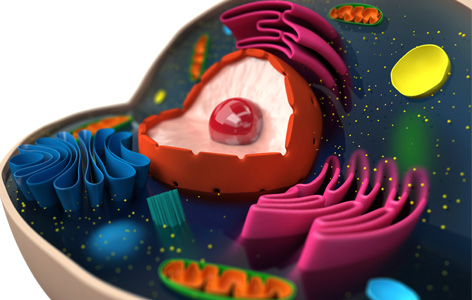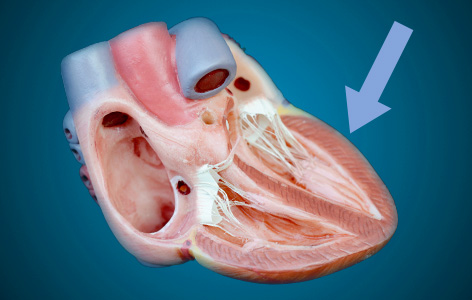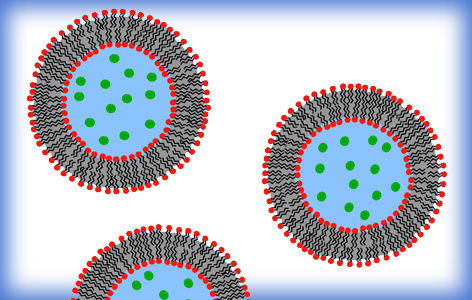 As UHN's monthly research newsletter, NRx reports on the full spectrum of research from UHN's five research institutes: the Princess Margaret (PM) Cancer Centre, the Toronto General Research Institute (TGRI), the Toronto Western Research Institute (TWRI), the Toronto Rehabilitation Institute (TRI) and the Techna Institute (Techna).
As UHN's monthly research newsletter, NRx reports on the full spectrum of research from UHN's five research institutes: the Princess Margaret (PM) Cancer Centre, the Toronto General Research Institute (TGRI), the Toronto Western Research Institute (TWRI), the Toronto Rehabilitation Institute (TRI) and the Techna Institute (Techna).
In this issue you can read about:
- Robots that help individuals with Alzheimer disease
- Genes that drive multi-focal prostate cancer
- An antioxidant protein that causes the body to waste energy
- An effective, yet under-prescribed treatment for genetic emphysema
- How the cell controls levels of a protein implicated in heart disease
- Factors that limit effectiveness of an anticancer drug delivery system
- Dr. Milos Popovic: the UHN Inventor of the Year
We hope that you will find NRx informative. If you have feedback or questions, please contact www@uhnresearch.ca.
Christopher J. Paige, PhD, FCAHS
Vice President, Research
University Health Network
Researchers identify factors that affect interactions between robots and adults with dementia

The ED mobile robotic system is voice activated and interacts with the user through audio and video prompts.
As Canada's population ages, an increasing number of individuals will be afflicted with dementia and Alzheimer disease (AD). Canada's health care system currently lacks the resources to provide long-term care for this growing population. A potential solution to this problem is the development of technologies to enable older adults to maintain their independence while they age at home.
One example of this approach, which is being led by TRI researchers, is the development of mobile robotic systems that help individuals complete daily tasks. But designing robots that are able to interact with those with AD remains a challenge because these individuals often have difficulty speaking clearly—a symptom that worsens as the disease progresses.
TRI Scientists Drs. Frank Rudzicz and Alex Mihailidis ran a series of experiments to identify patterns of communication between robots and people with AD as the latter performed daily tasks. By analyzing the behaviour of participants, the research team found that 40% of the interactions with the robot would cease because the participant would simply begin to ignore the robot. This often occurred after participants showed signs of confusion or misunderstanding.
Explains Dr. Rudzicz, "Our study has pinpointed the behaviours that influence communication breakdown between robots and adults with AD. We are now trying to develop speech recognition systems that automatically detect these behaviours to facilitate more successful interactions between robots and individuals who have AD."
This work was supported by the Canadian Institutes of Health Research, the Natural Sciences and Engineering Research Council of Canada, the Nuance Foundation and the Toronto Rehab Foundation.
Speech interaction with personal assistive robots supporting aging at home for individuals with Alzheimer's disease. Rudzicz F, Wang R, Begum M, Mihailidis A. ACM Transactions on Accessible Computing. 2015 May. [Pubmed abstract]
New findings bring us one step closer to determining disease aggression and personalized treatments for individuals with multi-focal prostate cancer

Age is the strongest risk factor for prostate cancer—risk increases at age 50, and most cases are diagnosed in men over the age of 65.
Researchers at UHN have recently drawn a molecular portrait that provides the first complete picture of localized, multi-focal prostate cancer—a disease in which multiple tumours develop within the prostate. This exciting study also unveils a new gene subgroup driving this tumour development.
The study, led by PM Senior Scientist Dr. Robert Bristow, involved the molecular profiling of 74 patients with Gleason Score 7 index tumours—this is the classification system used to evaluate aggressiveness in prostate tumours. Of these, whole-genome sequencing was done on 23 multiple tumour specimens from five patients whose prostates were removed at surgery. By analyzing the genetics of the different cancers within each prostate, "aggression scores" were assigned to each cancer, which revealed that even small cancers can contain aggressive cells capable of altering a patient's prognosis. Moreover, detailed analysis showed that two members of the MYC cancer gene family were at play in development of the disease and one of them, C-MYC, was the culprit in driving aggressive disease.
Dr. Bristow says that about half of all prostate cancer patients either have C-MYC or L-MYC mutations, but never both. "Our findings suggest that we are getting closer to subtyping the cancer based on which gene is present to determine a patients' disease aggression in terms of the risk of spread outside the prostate gland at time of treatment. Using this data we aim to develop a clinical test within the next three years that is capable of informing doctors and patients about specialized treatments for each prostate cancer patient."
This work was supported by the Movember Foundation through Prostate Cancer Canada, the Ontario Institute for Cancer Research, the Government of Ontario and The Princess Margaret Cancer Foundation.
Spatial genomic heterogeneity within localized, multifocal prostate cancer. Boutros PC et al. Nature Genetics. 2015 May 25. [Pubmed abstract]
An antioxidant protein that promotes the efficient use of food may be linked to obesity

DJ-1 promotes the efficient use of energy within mitochondria (pictured as green and orange structures), the 'powerhouses' of cells.
In the process of converting food into energy, harmful by-products called reactive oxygen species (ROS) are generated. The harmful effects of ROS are normally cancelled out by antioxidant proteins, but overeating and lack of physical activity can lead to ROS overproduction—effects that when combined are thought to cause cell stress, obesity and metabolic diseases like diabetes.
Surprisingly, restricting calories and exercising also stimulate ROS overproduction, yet these lifestyle changes do not lead to obesity. Given these contradictory outcomes, more research is needed to determine how the balance between ROS and antioxidants promotes positive or negative metabolic changes.
A study led by TGRI Scientist Dr. Minna Woo provides new insight into the link between ROS and the development of obesity-related metabolic diseases. Her team found that muscle cells exposed to high amounts of fats produce elevated levels of ROS. As expected, when the antioxidant protein known as DJ-1 was turned off ROS levels increased even more. What was surprising was that the absence of DJ-1 turned on a program that caused the cells to waste energy. The energy was therefore not stored as fat, providing protection against obesity and diabetes.
"This novel metabolic function of DJ-1 reveals its essential role in the effective conservation of energy in times of famine. Abolishing the activity of DJ-1 leads to fuel wasting, which is exactly what we need in the modern world of calorie excess and sedentary lifestyle," says Dr. Woo. "Our study illustrates how interventions that target programming of energy use may be a new therapeutic strategy for people with obesity or diabetes."
This work was supported by the Canadian Institutes of Health Research, the Canadian Diabetes Association and the Toronto General & Western Hospital Foundation. M Woo holds a Tier 2 Canada Research Chair in Signal Transduction in Diabetes Pathogenesis and T Mak holds a Tier 1 Canada Research Chair in Inflammation Responses and Traumatic Injury.
DJ-1 links muscle ROS production with metabolic reprogramming and systemic energy homeostasis in mice. Shi SY, Lu SY, Sivasubramaniyam T, Revelo XS, Cai EP, Luk CT, Schroer SA, Patel P, Kim RH, Bombardier E, Quadrilatero J, Tupling AR, Mak TW, Winer DA and Woo M. Nature Communications. 2015 Jun 16. [Pubmed abstract]
Treatment that increases blood levels of missing protein slows progress of this debilitating disease

Emphysema can be treated with oxygen, inhaled medications (pictured) or a lung transplant, depending on the severity of symptoms.
Emphysema is a chronic disease of the lungs characterized by shortness of breath that worsens over time. A genetic form of the disease is caused by an inheritable deficiency of the α1 antitrypsin (AAT) protein, leaving the lungs more susceptible to the type of damage that leads to emphysema.
Augmentation therapy is a treatment for the genetic form of emphysema. It involves weekly intravenous injections of purified AAT to boost its levels in the blood and lungs. Although the therapy has been available for over 25 years, it is rarely prescribed to patients because there has been a lack of evidence showing that the treatment actually protects the lungs.
A study led by TWRI clinical researcher Dr. Kenneth Chapman has produced compelling evidence that augmentation therapy does in fact slow the progression of lung damage in people with AAT deficiency. The findings were recently published in the prestigious medical journal The Lancet.
As part of the study, 180 people with emphysema and low blood levels of AAT received either the augmentation therapy or a placebo containing no protein. After two years of treatment, researchers discovered that the participants who received augmentation therapy had less damage to their lungs than those receiving the placebo.
"Patients with AAT deficiency need timely access to diagnosis and treatment to ensure that they receive the best possible care. Augmentation therapy has the potential to add years to a patient's life", says Dr. Chapman of the findings.
This work was supported by CSL Behring and the Toronto General & Western Hospital Foundation.
Intravenous augmentation treatment and lung density in severe a1 antitrypsin deficiency (RAPID): a randomised, double-blind, placebo-controlled trial. Chapman KR, Burdon JG, Piitulainen E, Sandhaus RA, Seersholm N, Stocks JM, Stoel BC, Huang L, Yao Z, Edelman JM, McElvaney NG; RAPID Trial Study Group. The Lancet. 2015 May 27. [Pubmed abstract]
Study reveals how muscle cells control the levels of a protein implicated in heart disease

Dilated cardiomyopathy causes a third of all cases of congestive heart failure and occurs when muscles that line the chambers of the heart (indicated with arrow) are weakened.
Diseases that weaken the ability of muscles of the heart to contract are known as cardiomyopathies. One of these diseases, known as familial dilated cardiomyopathy, is an inherited condition in which the muscles of the heart become dangerously stretched out, leading to heart failure. Some people with this disease have been found to have defects in a protein known as phospholamban (PLN), which is involved muscle contraction.
Muscle contraction involves a series of complex molecular events and is a process that depends on calcium. Myofilaments—the microscopic fibres found within muscle cells—respond to changes in calcium levels in the cell. When calcium levels are high, muscles contract; when they are low, muscles relax.
PLN has been shown to decrease the robustness of muscle contractions by reducing the amount of calcium that is available for muscle contraction. Despite the importance of PLN, little is known about how the cell controls levels of the protein.
To help shed light on PLN regulation, a group of researchers led by TGRI Scientist Dr. Anthony Gramolini explored the detailed steps taken by cells to break down PLN. "We found that PLN is chemically tagged by ubiquitin, which targets a protein to be broken down through a process known as selective autophagy." says Dr. Gramolini.
Also explored were the effects of a drug known as metformin, which is the most widely used drug for type II diabetes. Dr. Gramolini explains, "We found that metformin promotes degradation of PLN. Because certain experimental models have shown that metformin has a cardioprotective effect, our findings suggest that by reducing PLN, metformin may act by increasing the amount of calcium available to myofilaments in the heart."
Supported by the Heart and Stroke Foundation, the Heart and Stroke/Richard Lewar Centre of Excellence, the Canadian Institutes of Health Research, the Ontario Research Fund and the Toronto General & Western Hospital Foundation. AOG is a Tier 2 Canada Research Chair in Cardiovascular Proteomics and Molecular Therapeutics.
Metformin increases degradation of phospholamban via autophagy in cardiomyocytes. Teng AC, Miyake T, Yokoe S, Zhang L, Rezende LM Jr, Sharma P, MacLennan DH, Liu PP, Gramolini AO. Proc Natl Acad Sci U S A. 2015 May 26. [Pubmed abstract]
Liposome drug delivery increases tumour dose—but the distribution of the drug limits effectiveness

Liposomes are nanoscopic (~100 nm) bubbles made of lipids (the same material as a cell membrane) that can carry drugs (green dots in the illustration above).
A liposome is a small laboratory-made particle that in some ways resembles a miniature cell—a membrane that is capable of encasing chemical contents. Liposomes are being developed to deliver drugs used in cancer therapy to therapeutic targets. While liposomes accumulate preferentially in cancerous tumours due to their size, in practice their use in cancer drug delivery has not led to meaningful improvements in shrinking tumours.
Techna Director Dr. David Jaffray and colleagues have identified several factors that could explain the shortfall, including that the distribution of liposomes within a tumour is often uneven. Thus, while using liposomes might increase the overall amount of drug inside a tumour, certain parts of the tumour may receive much less of the drug.
In their most recent study, the team examined two key factors that control liposome delivery within tumours: interstitial fluid pressure (IFP) and tumour blood flow.
Using liposomes loaded with iodine that can be measured with CT imaging, Dr. Jaffray's team found that tumour blood flow best predicted the distribution of liposomes. IFP was not as good a predictor of drug distribution—a fortunate finding, as it is difficult to measure clinically.
Quantitative imaging methods are already being developed to non-invasively determine tumour blood flow. These methods may allow physicians to identify patients that are more likely to benefit from liposome-based therapies. "We are interested in the barriers to performance of current therapies. In radiotherapy, imaging has enabled us to increase performance by knowing where to target the radiation. Imaging can also help us understand factors affecting the delivery of drugs," concludes Dr. Jaffray.
This work was supported by the Natural Sciences and Engineering Research Council, the Terry Fox Foundation, the Canadian Institutes of Health Research and The Princess Margaret Cancer Foundation.
The intra-tumoral relationship between microcirculation, interstitial fluid pressure and liposome accumulation. Stapleton S, Milosevic M, Tannock IF, Allen C, Jaffray DA. Journal of Controlled Release. 2015 Jun 10. [Pubmed abstract]
Dr. Popovic honoured for technology that helps individuals regain control after paralysis

Dr. Milos Popovic.
At UHN's Annual General Meeting (AGM) on June 17, 2015, TRI Senior Scientist Dr. Milos Popovic was presented with the 2014 UHN Inventor of the Year Award.
The award, sponsored by UHN's Technology Development and Commercialization (TDC) office, recognizes UHN researchers that have demonstrated excellence in translating their findings into new technologies, services and products that improve health. Dr. Popovic received the award for his groundbreaking neurorehabilation research, which has led to the creation of a new product called MyndMove™.
Licenced by the Mississauga-based MyndTec Inc., the innovative technology can help restore the control of voluntary arm and hand movements after stroke or spinal cord injury. Remarkably, Myndmove™ can also restore function many years post-injury.
During treatment, a patient actively attempts a movement (eg, grasping an object) while a therapist uses the non-invasive device to stimulate various sets of muscles to create functional movements. This strengthens new neural connections specific to each patient that expedite recovery from paralysis.
The technology has been licenced for use in Canada and is currently available at designated clinics across Ontario. For more information, see the official press release.
 At UHN's Annual General Meeting on June 17, 2015, and after six months of serving as UHN President and CEO, Dr. Peter Pisters presented his observations and vision for the future of UHN.
At UHN's Annual General Meeting on June 17, 2015, and after six months of serving as UHN President and CEO, Dr. Peter Pisters presented his observations and vision for the future of UHN.  Dr. Jenny Heathcote, former Senior Scientist at TWRI, is the recipient of the 2015 UHN Global Impact Award.
Dr. Jenny Heathcote, former Senior Scientist at TWRI, is the recipient of the 2015 UHN Global Impact Award.  PM Cancer Centre Senior Scientist Dr.
PM Cancer Centre Senior Scientist Dr.